The Hungarian Communist Party (HCP) concluded after the 1945 general elections that the results would have to be corrected in its favour by every possible means, extra-parliamentary or otherwise. Mátyás Rákosi described in a report in 1947 how the Communists had set about trying to split the winning Independent Smallholders´ Party immediately the elections were over. They also made plans to restrict the franchise on discriminatory political grounds. There is no evidence that the Soviets tried to curb HCP energy in this respect. On the contrary, Moscow connived in most of the efforts to turn Hungarian democracy into `people´s democracy´.
The Smallholders, having won the elections, strove to project the results onto the way positions of executive power were shared. Under the Provisional National Government, most of the key local-government positions of mayor and recorder had gone to Communists, and to a lesser extent Social Democrats. Communist dominance was still greater among senior police officers. Apart from pushing for `proportionality´ in government appointments, the Smallholders wanted to remedy excesses committed during the land reform, when some large and even medium-sized peasant holdings had been carved up as well. They proposed holding local-government elections and giving the Peasants´ Association, as the representative organization in agriculture, rights comparable to those of a trade union. The Communists took the opposite view on each of these issues. This caused a succession of coalition crises from March 1946 until the resignation of Prime Minister Ferenc Nagy 15 months later. The crises steadily narrowed the scope for Hungarian democracy, until it disappeared on May 30, 1947, with the arrest and emigration of the legitimate leaders of the leading coalition party.
The Communists had no experience of operating a multiparty democracy, but most of their leaders adapted excellently to the situation, notably Rákosi.
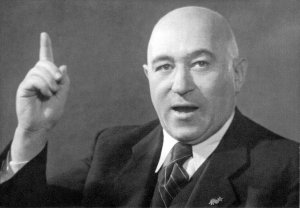 |
Mátyás Rákosi |
What tended to develop was a specifically Hungarian feature. Substantive political decisions were taken at small, unpublicized, informal meetings of coalition-party leaders, known as inter-party meetings.
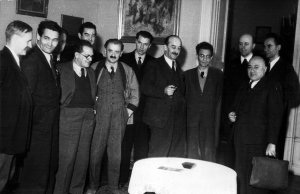 |
An inter-party meeting in the apartments of Zoltán Tildy. From the left: Péter Veres, Ferenc Erdei and Árpád Szakasits; behind them: Imre Kovács, Zoltán Tildy, Antal Bán, Ferenc Nagy, József Révai, Béla Varga and Mátyás Rákosi |
There the Communists, better informed and never reluctant to flaunt their Soviet connections, could apply methods of pressurizing, blackmail and political bargaining. While drawing strength from the Soviet occupation, the Communists believed that time was on their side. The other party leaders showed a chronic lack of confidence that left them perplexed about the distant future. They could clearly not rely on the Western powers. The United States often protested against Hungarian infringements of democracy and market principles but never took practical steps, just as it had looked on impassively while the Soviet Union built `people´s democracies´ in directly neighbouring countries in 1945-6. All the evidence suggested that the West had written off the region. Stalin and his Communist henchmen could cite Soviet security reasons for doing whatever they wished. Furthermore, the Communists operated an excellent propaganda machine, through the young intellectuals who had joined them, claiming every success as the party´s.
The first major stage in tempering the results of the 1945 elections was the establishment of a Supreme Economic Council (SEC), which operated from November 1945 to January 1946. The SEC, with its Communist-led secretariat, received the right to issue decrees, which made it the main state body for directing the economy, able to sidestep Parliament and even the prime minister. The next stage came early in March 1946. The HCP put extra-parliamentary pressure on the Smallholders (through a press campaign and mass demonstrations), calling for increased state control over the economy (state management of the mines and banks) and other measures. There was a split in the political elite. The coalition remained in office, but the HCP initiated the formation of a Left-Wing Bloc, consisting of the Communists, the Social Democrats and the National Peasants´ Party, opposed to the Smallholders on almost every political issue.
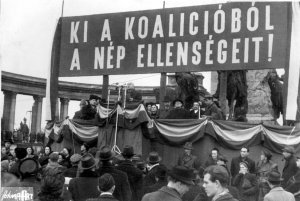 |
Formation of the Left-Wing Bloc. The spokesman at a mass rally in Hősök tere (Heroes´ Square) in Budapest is Mátyás Rákosi, with Árpád Szakasits beside him and Péter Veres behind.
|
The Smallholders, faced with this intense political pressure, chose to back down in most cases. The party agreed, for instance, to expel 21 ostensibly reactionary members from its parliamentary group and thereby lost its absolute majority in the National Assembly. The expelled members, headed by Dezső Sulyok, established an opposition faction called the Freedom Party, which attacked the policies of the Communists and the Left-Wing Bloc.
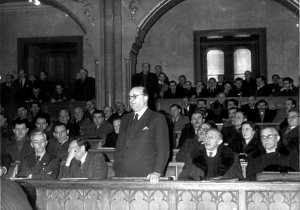 |
Dezső Sulyok addresses Parliament |
The pliancy of Ferenc Nagy had much to do with the imminent peace negotiations. He felt that confronting the Communists would damage the country´s none-too-favourable standing with Moscow. Rákosi´s bargaining position was that in return for Smallholder concessions to the Communists, he would intercede with the Soviet leaders on Hungary´s peace objectives. It seems unlikely that even Rákosi heard the real Soviet position, which was plainly anti-Hungarian, irrespective of the political manoeuvrings to further Soviet interests. On March 21, 1946, a week after the Smallholders had yielded to the Left-Wing Bloc, the Politburo of the Communist Party of the Soviet Union agreed on the Soviet position on the Hungarian and Bulgarian peace treaties, to present to a conference of deputy foreign ministers in London. This stated explicitly that the whole of Transylvania was to be ceded to Romania and Hungary return to its borders of December 31, 1937. Yet Stalin told the Hungarian government delegation on April 10, 1946 that based on the Romanian armistice agreement, `There are some grounds for Hungary to receive something, but exactly what, how great a part, will have to be seen... This question has to be negotiated.´
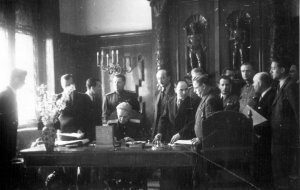 |
Signature of the Hungarian-Soviet agreement on reparations |
In the light of the Politburo position just mentioned and of later events, this can be called a diversionary tactic. So can the duplicity shown by the Soviet leadership over the question of unilaterally deporting members of the Hungarian minority from Czechoslovakia. At the talks on April 10, Stalin first outlined the advantages of a complete population exchange, citing the example of the Soviet Union and Poland. He dwelt on the danger that Hungarians remaining in Slovakia would become assimilated into the majority Slovak community. Finally, he added, `The desire to secure the civil rights of the Hungarian national minority seems to be justified... The Soviet government will try to cooperate on ensuring that this question is regularized.´ Only subsequently, in answer to a question from Czechoslovak leaders at talks early in July 1945, did Stalin reveal his true position: `Fierlinger asks what is to happen about deporting the Germans and Hungarians from Czechoslovakia. J.V. Stalin says the following: We will not intervene in this. Chase them out!´ In the event, members of the Hungarian minority in Slovakia were invited to choose between declaring themselves Slovaks or losing (not receiving back) their citizenship. The moves towards, `ethnic cleansing´ prompted large numbers of Hungarians to flee to Hungary. These events caused great indignation among people in Hungary, irrespective of their political persuasions. In February 1946, Hungary and Czechoslovakia held tense bilateral negotiations. These led to an agreement on a population exchange between the two countries, under which Czechoslovakia was allowed to deport as many Hungarians as Slovaks from Hungary applied for resettlement in Czechoslovakia.
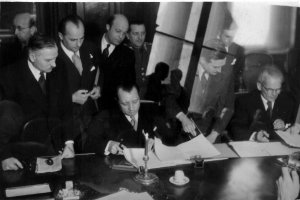 |
János Gyöngyösi (right) and Vladimire Clementis sign the agreement on the Hungarian-Czechoslovak population exchange. Daniel Okli is on the extreme left |
Less than 80,000 Hungarian Slovaks did so, despite a huge publicity campaign, but President Eduard Benes continued to nurture plans to deport 200,000 Hungarians unilaterally.
On June 17, 1946, there was an attack on Soviet soldiers in the centre of Budapest, under circumstances that remain obscure to this day. Since the alleged assailant was a member of the Catholic-run Scouts Association, the chairman of the Allied Control Commission (ACC), Lieutenant General Sviridov, argued in a note handed to the Hungarian government that `every kind of underground fascist organization that deals with propaganda and acts of terrorism finds a legal form for itself in the Independent Smallholders´ Party.´ He accused a dozen Smallholder members of Parliament and party officials by name of carrying on `anti-Soviet, pro-fascist´ propaganda or `occupying a high position in the state apparatus while openly or covertly supporting fascist elements´ through their work. László Rajk,
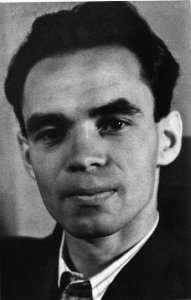 |
the Communist minister of the interior, did not wait for a government decision before banning most of the civil, religious, youth and other associations. This was a blow to the voluntary, civil dimension of society, which had provided a basis for democratic political activity.
In the summer of 1946, the peace conference convened in Paris, intending to create a new, hopefully democratic system in post-war Europe. It had become increasingly apparent during the preparations for the conference that there were divisions among the anti-fascist Allies. These were later to prevent the conclusion of a peace treaty with Germany and reunion of the Western and Soviet zones of occupation. However, the great powers agreed on most important questions affecting Hungary. The Hungarian government and political parties were of the opinion that it would be possible to correct in the new treaty at least some of the injustices in the 1920 Treaty of Trianon. There seemed to be no hope of altering the frontiers with Czechoslovakia, Yugoslavia or Austria, but there were some hopes over Transylvania and of reducing the reparations that the Allies were demanding. The Hungarian government made strong diplomatic efforts in the spring and summer of 1946, sending high-level delegations to Moscow, Washington, London and Paris.
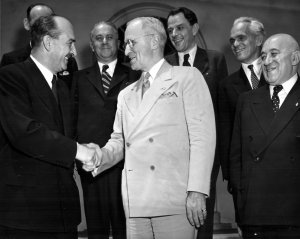 |
American Envoy Truman receives a government delegation headed by Ferenc Nagy(Hungarian National Museum, Historical Photograph Archives) |
The relatively modest territorial claim against Romania (initially 22,000 sq. km, later reduced to 5000) was rejected before the peace conference began, at a meeting of the foreign ministers of the four great powers. A proposal by US Secretary of State James F. Byrnes to hand over some border areas with a predominantly Hungarian population was supported initially by the British and French, but opposed vehemently by Vyacheslav Molotov, the Soviet foreign minister. During the debates, first the French and later the British went over to the Soviet side, so that on May 7, 1946, the foreign ministers agreed to revert to the Trianon borders between Hungary and Romania as well. This was confirmed by the peace conference, which also acknowledged a Czechoslovak territorial claim for a bridgehead across the Danube from the Slovak capital, Bratislava (Pozsony), by ceding three of five villages claimed. As a result, a short length of the Danube came to be inside Czechoslovak territory. However, the conference rejected a Czechoslovak proposal to deport unilaterally several hundred thousand indigenous Hungarian inhabitants from Slovakia. This was already happening to the German communities in Central and Eastern Europe, even in Hungary, which deported several hundred thousand Germans between 1945 and 1948.
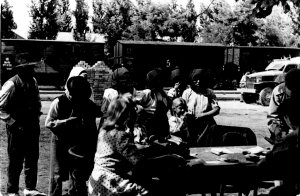 |
Deportation of Germans from Hungary |
Hungary´s efforts to reduce its reparation payments did not succeed either. Indeed, it also had to pay compensation for damage to assets owned by nationals of Allied countries, even if this had been caused by Allied bombing. German property in Hungary, including German claims under the Hungarian-German system of financial payments, was transferred to the Soviet Union. The Soviets turned the slice of Hungary´s national wealth obtained into capital contributions to joint companies, which came to dominate several industries of strategic importance (oil production, bauxite mining, aluminium production, and air and river transport). Unlike the Treaty of Trianon, the Paris Peace Treaty with Hungary did not contain clauses protecting ethnic and national minorities. It was signed at the end of February 1947
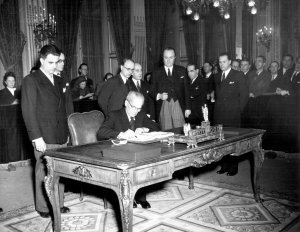 |
Foreign Minister János Gyöngyösi signs the Hungarian peace treaty in Paris |
and entered into force on September 15, when the ACC was disbanded.
That did not restore the country´s sovereignty, however. The Soviet troops did not withdraw when the treaty came into force, as many people had been expecting. They remained in Hungary, on the grounds that they had to maintain lines of communication with their forces in Austria. Hungary therefore remained an occupied country.
The successful economic stabilization and the conclusion of the peace treaty (although it belied all Hungary´s hopes) meant that by the early autumn of 1946, most of the urgent national tasks arising from the military defeat had been accomplished. This brought a marked deterioration in the political cohesion of the grand coalition. Every political party faced a dilemma. If the country regained its sovereignty within the foreseeable future, there would probably be greater freedom for the country to arrange its future affairs. The leaders of the HCP were obviously determined to correct further the results of the democratic elections of 1945. If they could not do so by other means, this would mean holding new elections, in which the Left-Wing Bloc would presumably oppose the Smallholders´ Party, or the ostensibly reactionary forces that had split off from it. That at least seemed to be the thinking behind a further political offensive, launched by the Communists in the autumn. Rákosi emphasized at a congress of the HCP, held at the end of September, that the country was progressing along the road of people´s democracy. Towards the end of his speech, he made it plain that this road led to Soviet-style socialism. He cast aspersions on the legitimacy of some elected members of Parliament. He also proposed to restrict the franchise by applying political criteria and to continue applying pressure on mass movements. The main slogan of the political report - `Get the enemies of the people out of the coalition!´ - meant that the HCP had resolved, after a year´s delay, to turn Hungary into one of the `people´s democracies´. The Left-Wing Bloc demanded nationalization of larger flour mills and municipalizing of smaller ones, along with the formation of a `democratic´ (i.e. Communist-led) body to represent the peasants.
The ensuing inter-party conference on October 30, 1946 became a dialogue of the deaf. Prime Minister Ferenc Nagy showed a clear grasp of the situation. `Among the parties of the Left-Wing Bloc,´ he said, `and more immediately, the leaders and masses of the workers´ parties, the idea has become dominant that there are counterrevolutionary endeavours at work in Hungary, seeking to overthrow democracy, and that these efforts receive support, partly or wholly, from one of the coalition parties, the largest one, the Independent Smallholders´ Party.´ There was also plain speaking from Ernő Gerő on the Communist side, who argued that the 1945 elections results had not corresponded with the actual relative strengths of popular support for the political parties. `The elections produced those results because there is reaction in Hungary, which showed a very correct instinct from its own point of view. It did not allow its forces to fragment, it concentrated its forces, and it sought to concentrate them in the party it found most appropriate for doing so... Since then, the way matters have stood at the Smallholders´ Party, it has been a complete captive of reaction, and the question now is whether it is capable of cutting the ties that bind it to that reaction in Hungary.´
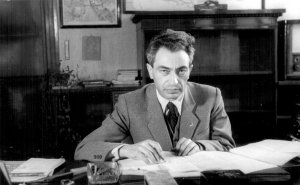 |
Ernő Gerő |
In the end, the sides failed to agree on any of the specific issues, so that only general declarations were made.
In April 1946, the Soviet leadership took up the idea of grouping the communist parties of the `people´s democracies´ under an organization similar to Comintern, which had been disbanded in 1943. The leaders of these parties were told in confidence that they were expected to take decisive measures to obtain communist hegemony or even dictatorship, although Moscow did not prescribe detailed scenarios at that stage. Rákosi, in any case, made efforts to overhaul the other party leaders of Eastern Europe in this. `Let us start with mass mobilization, with calling the masses to action,´ he told Communist members of Parliament at the end of November 1946. `Let us do this by stages. We should not call on the masses to force a change of government straight away, but encourage them to act against black-marketeers and obtain prosecutions of them by the courts.´
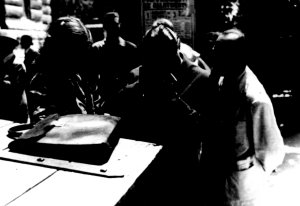 |
Black marketeers behind the Stock Exchange building |
The reason for the caution was pinpointed by Márton Horváth: `The policy of the Soviet Union is to promote peace and order in the countries it occupies... The Soviet Union has no interest in altering its policy just because we have fallen behind here, and thereby hand the West a trump card. We have to make up for our backwardness by our own efforts, and for that reason, we have to prepare for slow, persistent progress over the longer term.´
However, the Communist-led Interior-Ministry organizations had a chance to deal the Smallholders´ Party a decisive blow quite quickly, when a relatively insignificant secret political intrigue was discovered in December 1946. This involved the political activities of groups whose members believed naively that the Soviet forces would withdraw after the peace treaty was ratified and Hungary even move out of the Soviet sphere of influence. They drew up various general political plans for this eventuality. Some of the members of the group had belonged before the war to a secret `race-protection´ organization called the Hungarian Community, which had been anti-Semitic, but also anti-German. Others, on the other hand, were distantly acquainted with some leaders of the Smallholders´ Party. That gave enough grounds for the Communist-controlled secret police to posit a large `conspiratorial´ network of several hundred people, extending as far as some Smallholder leaders, ministers and MPs. The best known politician in the society was György Donáth, who had been a government MP before the war. Lajos Dálnoki Veress, also involved, was a general whom Horthy had appointed as his deputy, in case anything should happen to him during the abortive attempt to bail out of the war. The society denied the whole legality of Hungarian statehood since December 1944. For this, if no other reason, they could not have had anything substantial in common with the Smallholders, who were providing the heads of state and government.
Nonetheless, the Communists saw the potential in their `discovery´. The Communist commander of the military secret service (the Military Policy Department of the Defence Ministry) immediately dismissed Albert Bartha, the Smallholder defence minister, when the latter wanted to talk to those arrested. The interrogation of the prisoners at the State Defence Department of the Interior Ministry, where they were taken, was directed personally by the Communist interior minister, László Rajk. Rákosi addressed the HCP Central Committee early in January: `This conspiracy has enormous significance for us because it confirms in detail and in full all we have been saying about reaction trying to work through the Smallholders´ Party... This conspiracy has great significance because it will strongly affect the whole course of the strategy we have planned for the year 1947. This is a heavy stone, which is still flying through the air, and there is no knowing where it will strike. We must do our best to maximize its effect.´
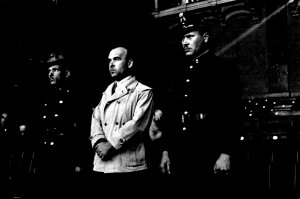 |
György Donáth before the court during the trial for conspiracy against the Republic |
The Smallholder leadership realized they were in deep trouble when the state security service tried to arrest Kálmán Saláta, the secretary to Prime Minister Ferenc Nagy. (In the event, Saláta managed to flee abroad.) The prime minister could expect no help from the West or from the Soviet heads of the ACC in Hungary. The latter remarked that they had already warned Nagy to purge his party of `reactionary elements´.
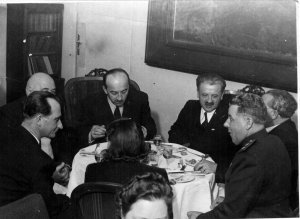 |
A reception hosted by Zoltán Tildy. By the table are Soviet General Sviridov, Árpád Szakasits, Ferenc Nagy and Mátyás Rákosi |
Initially, therefore, the Smallholders´ Party continued its usual policy of making concessions, agreeing to the legislature suspending the parliamentary immunity of six members, who were immediately arrested. However, the HCP did not want to stop there. The prime target in the conspiracy affair became Béla Kovács, the general secretary of the Smallholders´ Party, whose surrender to the prosecution service was rejected by the National Assembly for the time being.
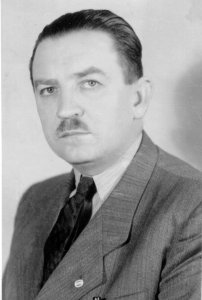 |
Béla Kovács |
At Rákosi´s request, Kovács was then arrested on February 25, 1947 by the Soviet state security service, acting on instructions from the ACC, and carried off to the Soviet Union. The decisive step was therefore taken in the Soviet Union and elicited strong international reactions. On March 12, US President Harry S. Truman underlined in a famous speech to Congress what became known as the Truman Doctrine: `The peoples of a number of countries of the world have recently had totalitarian regimes forced upon them against their will. The Government of the United States has made frequent protests against coercion and intimidation, in violation of the Yalta agreement, in Poland, Rumania and Bulgaria. I must also state that in a number of countires there have been similar developments .´
This strong American reaction, also conveyed in sharply worded diplomatic notes, made the Soviet leadership more cautious. There could be no question of concessions over Kovács, of course, but Moscow saw things differently from Rákosi, who was intensely irritated by the continued Smallholder resistance, just when the party seemed to be beaten and victory imminent. At an inter-party meeting on March 12, 1947, Ferenc Nagy demanded, in return for purging the Smallholders´ Party, that the Left-Wing Bloc be disbanded. The leaders of the Smallholders´ Party proposed introducing human-rights legislation in Parliament. Although they were yielding to the left-wing pressure, the situation still foreboded a government crisis, as Ferenc Nagy threatened to resign. Rákosi concluded from this that the conspiracy question had been settled too soon from the political point of view. On April 4, 1947, the Central Committee of the HCP expressed `no doubt that Ferenc Nagy also bore very grave political responsibility, no doubt that he also knew about the conspiracy.´ It informed the Soviets as well of its conviction that `Prime Minister Ferenc Nagy certainly took part in the conspiracy. Indeed it can be presumed that he gave orders to the conspirators in the most recent period.´ Rákosi would have liked Kovács, broken by the Soviet secret police, to denounce the prime minister in a Hungarian show trial.
Rákosi was received on April 29, 1947 by Molotov, the Soviet foreign minister, and told that the Soviet forces would remain in Hungary after the ratification of the peace treaty. Rákosi asked whether Soviet troops would assist if the HCP `resorted to mobilizing the masses´ (i.e., if there were a Communist coup d´état), but Molotov rebuffed him. Nor would he agree to the extradition of Béla Kovács.
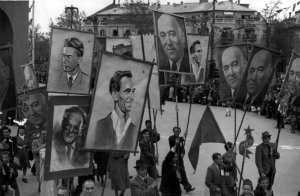 |
Marchers on May 1, 1947 bear pictures of Mátyás Rákosi, Árpád Szakasits, László Rajk and József Révai |
On May 14, 1947, Prime Minister Ferenc Nagy travelled to Switzerland on vacation. The Soviet leadership sent Rákosi a note urging him to seize this opportunity to be rid of the most eminent Smallholder politician. Nagy was accused of having secret negotiations in Switzerland aimed at overthrowing `people´s democracy´ in Hungary. The Soviet state security presented the Hungarians with ostensible confessions that compromised Nagy, whereupon Rákosi managed to persuade the government to summon the prime minister home and clear himself.
Ferenc Nagy had no desire to share the fate of Béla Kovács. As the Communists expected, he chose exile instead of returning home. His party became disorganized, having lost its parliamentary majority, through the spring setbacks, the arrests, the recalls of MPs and the resignations. It continued to provide a prime minister, Lajos Dinnyés, but he is best characterized by a contemporary pun on his surname: he was like a watermelon (dinnye)-green outside and red within. At the beginning of the summer, the Communists announced the slogan for the new elections, in which they wanted to stand as a bloc with the other coalition parties. Initially, the Social Democrats rejected the approach, but the HCP leaders were not pessimistic. As they wrote in a report to Moscow, `The comrades are confident and hope that on this occasion, they will remedy the mistakes made in 1945. There is a good chance of a democratic majority with substantially increased Communist influence, and in that way we can join the ranks of the progressive neighbouring countries.´ By the summer of 1947, the only Smallholder and National Peasants´ Party politicians remaining were ones who accepted unconditionally the leadership of the HCP. Thereafter, the independence of these parties was largely a sham, although several further purges of their leaders took place before the end of 1948.
In the general elections that took place in Hungary in August 1947, it was still possible for openly opposing parties to stand against the Communist-led coalition. Most of those that did so consisted of politicians who had left or been expelled from the Smallholders´ Party. The right-wing conservative Hungarian Independence Party was led by Zoltán Pfeiffer. István Barankovics, leader of the Democratic People´s Party, held Christian democratic, Christian socialist ideas. With his modern Christian approach, he opposed not only the Communists, but the Catholic clergy headed by the prince-primate, József Mindszenty, archbishop of Esztergom. The opposition forces were still hoping that the Soviet army would withdraw and the Western powers give support to the cause of embattled Hungarian democracy. Neither of these hopes was fulfilled.
Rákosi could not be sure of the outcome either. Unlike in 1945, the Communists therefore resorted to some effective methods of influencing the election results in advance. The new electoral law narrowed the franchise by applying political criteria. (Even people who had played a paltry role in the Horthy regime were disenfranchised, among them being Dezső Sulyok, whose Freedom Party therefore did not stand in the elections.) The Communist-influenced committees that compiled the electoral roll simply left off several hundred thousand names. Electoral fraud was also perpetrated to obtain the desired results. (The system of ` blue chits´ providing absentee voters with extracts from the electoral role allowed Communist activists to travel round casting votes in as many as a dozen different places.) The coalition duly won the elections, but even so, it did not become the single political force, as the results show:
| Coalition | Opposition |
| Hungarian Communist Party 22.3% | Democratic People´s Party 16,4 % |
| Social Democratic Party 14,9 % | Hungarian Independence Party 5,3 % |
| Independent Smallholders Party 15,4 % | Independent Hungarian Democratic Party 13,4 % |
| National Peasant´s Party 8,3 % | Others 4,1 % |
| Total: 60,9 % | Total: 39,1 % |
The government was again formed by Lajos Dinnyés and most of the other non-communist members were fellow travellers like him. Rákosi again became a deputy prime minister and other Communists took the key portfolios.
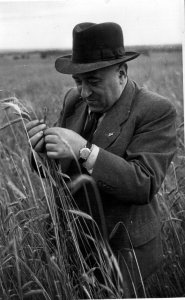 |
Mátyás Rákosi in a wheat field in Zala County |
However, that did not win the Communists the approval of the Soviet leadership. The plans for an election bloc had been reduced to an electoral alliance of four coalition parties and almost 40 per cent of the votes had gone to openly opposition parties. The results were even more embarrassing because Rákosi had forecast only two weeks earlier that the opposition would receive at most 15 per cent of the vote.
The Soviet leadership, in the summer of 1947, was taken up with far more important matters than how the takeover in Hungary was progressing. The United States had announced its four-year Marshall Plan for the economic recovery of Europe. This was based on the principle of mutual advantage. The American economy, which had expanded rapidly during the war, would find continuing markets that would stave off recession, while the war-torn countries of Europe would receive an injection of capital. The plan assumed that there would be integration in Western Europe. It stood by the principle of free trade. Among the political conditions attached were democracy and a constitutional state, in a Europe that was to include Germany. The Soviet Union showed some cautious initial interest, since the war damage had left it in dire need of outside assistance. However, the demand for an open and transparent economy was unacceptable to Moscow and the spectre of German reconstruction turned the Soviet interest into strong opposition. Meanwhile it became apparent that the former allies would not be able to agree even on the principles of a peace treaty with Germany. That removed the whole institutional basis for East-West cooperation. As a first step, the Soviet Union applied open pressure on Hungary and Czechoslovakia, forcing them to decline to take part in the European Recovery Plan. As Stalin told a Czechoslovak government delegation visiting the Kremlin on July 9, 1947, `In the guise of assisting Europe with credits, some kind of Western bloc is being organized against the Soviet Union...You would objectively be helping - willingly or unwillingly you would be giving assistance to isolating the Soviet Union... Your participation in the Marshall Plan will be judged as a victory over the Soviet Union. This we and our people cannot allow. You have to change your position, you have to refuse to participate, and the sooner you do so, the better.´
Rejection of the Marshall Plan gave new substance to some Soviet ideas that had been maturing since 1946. These were directed at some kind of cooperation among the more important European communist parties (in the Soviet-zone countries and in France and Italy, where the communists were still members of a coalition government). All these parties gave reports on the internal situation in their countries at the end of September 1947, at a meeting in Szklarska Poreba, Poland. The Hungarians reported it was `still an undecided question whether Hungary will be a people´s or a bourgeois democracy, whether it will join the new democracies or be a support to Anglo-American imperialism.´ There was strong criticism at Szklarska Poreba of the Western European communist parties, for being too `weak´ and `parliamentary´ and pursuing illusory `national roads´. This conveyed to all the participants that Moscow wanted a harder approach. The head of the Soviet delegation, Andrei Zhdanov, spoke of the world splitting into `two camps´ and Georgy Malenkov of the need for `organizational´ coordination and cooperation in the activity of the communist parties. The meeting established the Information Bureau of Communist and Workers´ Parties - Cominform - which organized regular summit meetings in subsequent years, to discuss current issues in the communist movement and convey Soviet directives to the other parties.
Moscow also decided to place state as well as party cooperation on a uniform footing at this time. In mid-October 1947, the CPSU Political Committee drew up a standard line on concluding mutual-assistance treaties with the smaller Eastern European countries (Bulgaria, Czechoslovakia, Hungary, Poland, Romania and Yugoslavia) or broadening agreements already reached. The assistance now applied to aggression from any power, not just Germany.
The Hungarian Communists concluded from the founding meeting of Cominform that they had a free hand to make further Soviet-style changes in the country. The first step they took was to dissolve the main opposition group, the Hungarian Independence Party, and deprive it of its seats in Parliament, after alleging election malpractices that were never proved. Its leader, Zoltán Pfeiffer, left the country. The Communists devised new guidelines for a state economic policy, putting forward socialist goals and seeking to introduce a new policy on cooperatives. Then came the break-up of the Social Democratic Party and preparations for a merger with the surviving faction of it.
The long traditions of antagonism between the Social Democrats and the Hungarian Communists had not been altered by the joint struggle they were waging for `people´s democracy´. In 1947, the Social Democrats again turned down a Communist proposal for an electoral bloc. After the elections, they bargained for a long time over the composition of the government and protested against the Communist electoral frauds. Now the Hungarian Communist leadership wanted to use the developments at Szklarska Poreba primarily against the Social Democrats. Early in 1948, the HCP took up the slogan of merging (`fusing´) the two parties and began a concerted campaign to woo members from the Social Democrats. The crypto-communists and sympathizers inside the Social Democratic Party played an active part in all this. A surge of membership transfers began at branch level. In February 1948 came developments among the leadership. The left, fellow-traveller wing of the Social Democrats (notably György Marosán) expelled the so-called right wing, which opposed the merger with the Communists (Anna Kéthly, Gyula Kelemen, Antal Bán and others), and agreed to a wholesale purge of the membership. (Only 240,000 out of more than 700,000 members were transferred to the merged party.)
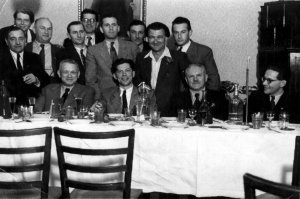 |
Farewell dinner for left-wing members of the Social Democratic Party (SZDP), before the merger congress. Second from the left is György Marosán, with Pál Justus on the extreme right |
Rákosi, seeing the merger as a matter of prestige, was not even deterred by the hesitant, cautious position taken by the Soviet party leadership. While receiving medical treatment at Barvikh, near Moscow, in December 1947, he outlined in a discussion with Stalin a plan to transform the Hungarian political scene. Stalin responded that the Social Democrats should `remain in a small, separate party.´ However, he `considered it correct to have the fusion with the Social Democrats first and then establish a [people´s front] organization, like the Soviets in the Soviet Union, placing the other parties round the communist core.´ Molotov also had words of caution when the Hungarian-Soviet Treaty of Friendship and Mutual Assistance was signed in Moscow in February 1948. Stalin, he said, warned against a rapid merger. Nonetheless, the action by the left-wing Social Democrats and the exclusion of the right-wing leaders from the party leadership at the end of February went down very well in Moscow, according to Rákosi.
On June 12, 1948, the two parties merged as the Hungarian Workers´ Party (HWP), adopting a largely communist political programme.
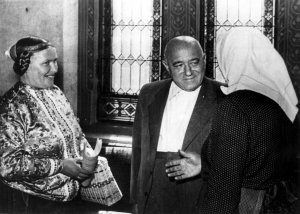 |
Rákosi speaks with peasant delegates in the corridor of Parliament, during an interval in the merger congress |
This made no mention of Sovietization of the country (introducing proletarian dictatorship, a command economy, etc.), but it did not refer to parliamentary democracy either. The political objective was to build socialism, which was not further defined.
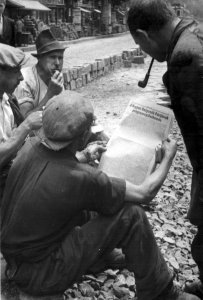 |
Workers reading the programme declaration of the Hungarian
Workers' Party (MDP) before the combined congress of the
merging parties
|
It was fruitless for the other coalition parties to exclude any of their leaders who disagreed with this objective. (The National Peasants´ Party ejected Imre Kovács for that reason before the 1947 elections, while the Smallholders rid themselves of Tivadar Pártay, for example.) It was also fruitless to express concurrence with the HWP programme. During 1948, the other coalition parties gradually faded from the political scene or became absorbed into the reorganized people´s front.
Absorbing the remnants of the Social Democratic Party in June 1948 still did not complete the process of political transformation in Hungary. There remained several relics of the earlier period within the institutional system of subordination prevalent in the Soviet sphere of interest. This amounted to little more than a semblance of political pluralism, because the other parties were simply adjuncts of the HWP, not rivals to it. In March 1948 came an economic coup. Parliament and the government were circumvented when an order went out to nationalize all factories in domestic ownership with more than a hundred hands.
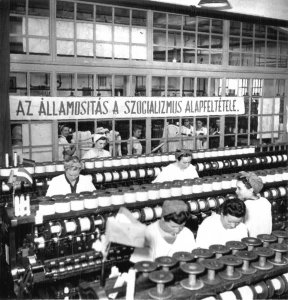 |
The First Hungarian Yarn Factory after nationalization |
Thereafter, the economic processes in the country were held tightly by the twin constraints of state ownership and state regulation. The Budapest stock exchange was closed. The three-year plan of 1947 had already restricted free enterprise, although it still did not contain performance targets broken down to the level of business units.
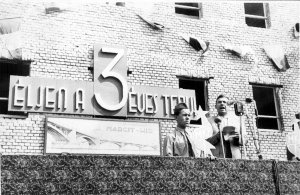 |
István Kossa speaks at a rally at the Ganz Shipyard to launch the Three-Year Plan |
The Hungarian economy, from 1948 onwards, can be considered a state-controlled economy, although voluntary associations, trade unions, churches and cultural institutions retained some freedom of action for a time. Freedom of the press was already restricted and the initial variety of cultural life was becoming uniform, although total control still did not apply. The transfer to a Soviet-style socialist system was on the agenda, but it could not be achieved immediately and the path towards it was not necessarily or exclusively one of violent compulsion.
Moscow, on the other hand, thought that the Hungarian party had not carried out the required political turn thoroughly enough. It was not sufficient for the countries of the Soviet zone to acknowledge their subordination in matters of foreign policy and security. The Soviet leadership saw any departure from the Soviet pattern as a factor that could weaken the Soviet camp in case of war. Stalin believed it was time to go beyond the period of various `people´s democracies´, `national roads´ to socialism and `relatively peaceful transitions´. The internal systems of the occupied and allied countries had to be brought into line with the requirements of the Cold War, in other words, made to comply with Soviet norms.
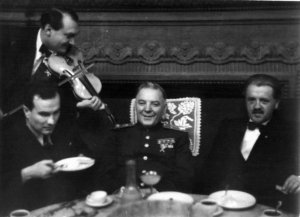 |
President Zoltán Tildy and his Soviet counterpart, Voroshilov, in the Gundel Restaurant |
That is how the Yugoslav-Soviet dispute came to degenerate into an open breach in the spring and summer of 1948. Tito and the other Yugoslav leaders viewed Yugoslavia as one of the leading forces behind the anti-fascist struggle, and therefore as more `advanced´ than the other people´s democracies of Central and Eastern Europe. Belgrade began to make claims, as a local medium-sized power, to lead the countries of the region towards socialism. This was seen in Moscow as a role reserved for the Soviet Union.
In the spring of 1948, Stalin began to prepare a thorough purge of the leaderships of the other communist parties. As the Soviet-Yugoslav breach took place, critical remarks were also made in Moscow about the Hungarian party leaders, but they remained unpublished because Rákosi and his colleagues learnt lessons from them in good time. The demise of political pluralism was followed by methodical elimination of all kinds of institutional and cultural pluralism. In August 1948, Rákosi announced that collectivization of agriculture into cooperative farms would begin. In June, all but a handful of church schools were nationalized. At Christmas came the arrest of the last great political figure to resist the spread of monolithic power, Cardinal József Mindszenty, archbishop of Esztergom and head of the Catholic Church.
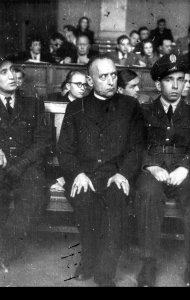 |
Cardinal József Mindszenty on the prisoner´s bench |
Mindszenty was sentenced in February 1949 to life imprisonment after legal proceedings modelled on the Moscow show trials. Influenced by this, the last significant opposition force , the Democratic People´s Party, announced that it was dissolving. Its leader, István Barankovics, delivered in Parliament a political testament for his party and the whole bourgeois opposition in post-1945 Hungary: `We have not changed, but circumstances have changed around us, due to the government´s policy. To acknowledge this change of circumstances and draw the conclusions from it - that may be what political wisdom dictates at this juncture. We are prepared rather to draw the consequences than to tame our programme to the altered circumstances.´ Barankovics himself fled to the West not long afterwards. During 1948 and 1949, the cultural and arts associations were reorganized so that the leadership passed in each case to persons committed to the HWP. A succession of literary and cultural journals ceased publication and many famous writers and artists left the country.
With the seizure of power, the sham coalition of 1947-9, in which the HCP and then the HWP enjoyed hegemony, gave way to a monolithic structure of political power. Real power passed to a narrow party leadership, for which the legislature, the government and the presidency simply became executive organizations. (After Zoltán Tildy had been ousted and placed under house arrest in 1948, the presidency passed to Árpád Szakasits, chairman of the Social Democratic Party and one of the leading fellow travellers.) The formal division of powers and democratic institutions remained and their role and the democratic rights were laid down in the constitution enacted on August 20, 1949, but this had no practical significance at all. Political power in Hungary had been transferred to the leaders of the HWP, indeed to a handful of people trained in the Moscow emigré community, above all Mátyás Rákosi (the general secretary), Ernő Gerő, Mihály Farkas and József Révai.
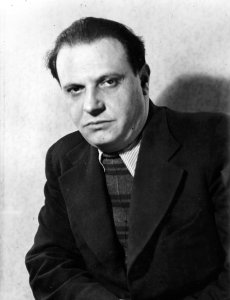 |
Mihály Farkas |
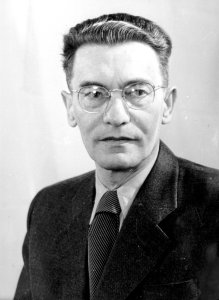 |
József Révai |
Please send comments or suggestions.
This page was created: Friday, 5-Dec-2003
Last updated: Friday, Wednesay, 10-Dec-2003
Copyright © 2003 The Institute for the History of the 1956 Hungarian Revolution